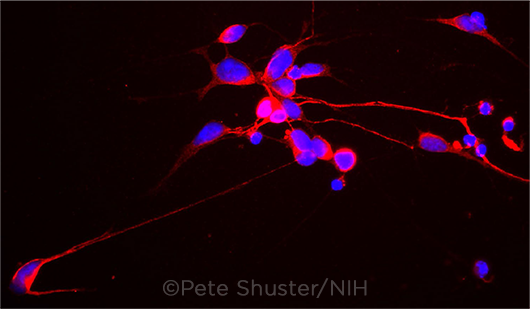Download PDF
Scientists at Boston University have detected another way in which the eye might serve as a window into the body’s health—this time via a neurodegenerative molecule’s presence in the vitreous at levels that correlate positively with levels of known biomarkers for Alzheimer disease (AD).1
The protein, neurofilament light chain (NfL), is a structural component of axons that is released into cytoplasm when axons degenerate. It has been identified in the cerebrospinal fluid and blood and appears to have potential as a screening tool and prognostic indicator in several neurological diseases, including multiple sclerosis.
 |
BIOMARKER. Human neuronal cells show fibrillar staining for NfL (red). Cell nuclei of some non-neuronal cells are also evident (blue).
|
Evaluating vitreous samples. In an earlier study, the Boston researchers found that amyloid-beta and tau proteins (biomarkers associated with AD) were present in vitreous—and that they positively correlated with patients’ scores on mental tests.2
For this study, the researchers looked for NfL, testing the vitreous from 77 patients (mean age, 56.2 years) who underwent planned vitrectomy. NfL was detected in all 77 vitreous samples, and NfL levels were positively associated with increased vitreous levels of amyloid-beta and t-tau, but not with p-tau181. They also were significantly associated with select inflammatory cytokines and vascular proteins—and they were not affected by other ocular conditions or by systemic diseases like hypertension and hyperlipidemia.1
Next up: sampling the aqueous. At this point, vitreous sampling is still too risky and expensive to be used as a screening tool to detect AD proteins, said Manju L. Subramanian, MD, the principal investigator. As for next steps, the Boston group has begun an NIH-funded study to determine whether NfL can be detected in aqueous. The researchers eventually hope to evaluate tear secretions, because tear testing would be even less invasive with fewer risks and low cost, making it an ideal screening tool, she said.
Why not use OCT to detect AD? Some researchers favor evaluating the eye with optical coherence tomography (OCT) to look for structural signs of AD. However, this can be problematic, Dr. Subramanian noted. “There are some ocular findings on OCT that can indicate a patient may have Alzheimer disease. But the data are conflicting, and there are a lot of local eye conditions that impact OCT measurements, such as diabetes, age-related macular degeneration, and glaucoma. And for those patients OCT testing may not work that well.”
Looking ahead. Further studies are needed to understand the sources of NfL in vitreous and to validate NfL levels in eye fluid and correlate them with other established biomarkers of neurodegeneration, Dr. Subramanian said.
Nonetheless, the results of this study suggest that NfL in vitreous might eventually prove to be a biomarker that physicians could use to screen for AD or to evaluate its progress, she said. “As an optical system, the eye allows us to actually visualize brain tissue. So if the eye can potentially be used as a diagnostic test for systemic diseases like Alzheimer, then the ophthalmologist might be playing a role in diagnosing neurodegenerative diseases in the future.”
—Linda Roach
___________________________
1 Subramanian ML et al. Alzheimers Res Ther. 2020;12(1):111.
2 Wright et al. J Alzheimers Dis. 2019;68(4):1429-1438.
___________________________
Relevant financial disclosures—Dr. Subramanian: None.
For full disclosures and the disclosure key, see below.
Full Financial Disclosures
Dr. Boland Carl Zeiss Meditec: C.
Dr. Ciolino TherOptix: C,O,P.
Dr. Delcourt Allergan: C; Bausch + Lomb: C; Laboratoires Théa: C; Novartis: C.
Dr. Subramanian None.
Disclosure Category
|
Code
|
Description
|
| Consultant/Advisor |
C |
Consultant fee, paid advisory boards, or fees for attending a meeting. |
| Employee |
E |
Employed by a commercial company. |
| Speakers bureau |
L |
Lecture fees or honoraria, travel fees or reimbursements when speaking at the invitation of a commercial company. |
| Equity owner |
O |
Equity ownership/stock options in publicly or privately traded firms, excluding mutual funds. |
| Patents/Royalty |
P |
Patents and/or royalties for intellectual property. |
| Grant support |
S |
Grant support or other financial support to the investigator from all sources, including research support from government agencies (e.g., NIH), foundations, device manufacturers, and/or pharmaceutical companies. |
|
More from this month’s News in Review